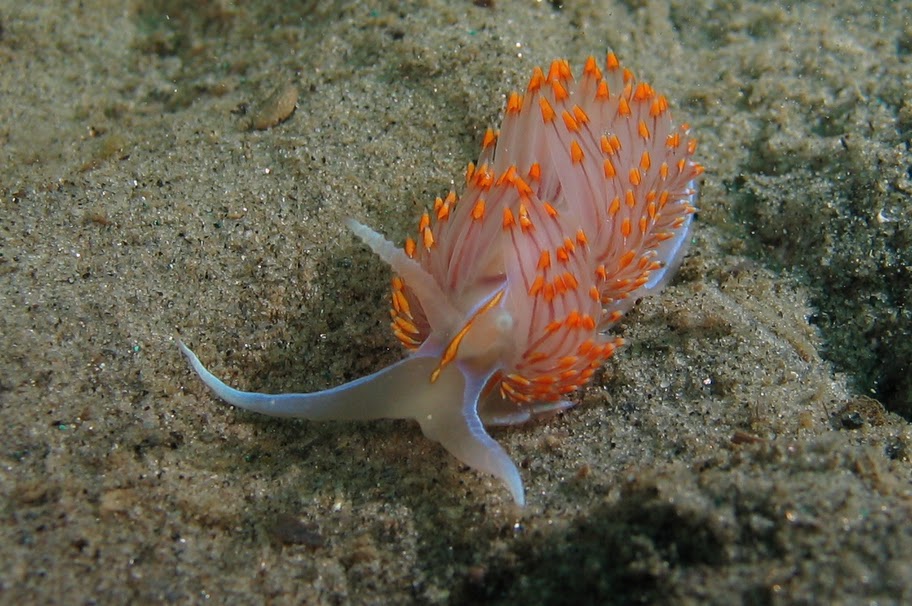Hermissenda crassicornis
From marinelife1011
| Opalescent Nudibranch | |
|---|---|
 |
|
| The Opalescent Nudibranch drawn by Drew Clendening | |
| Scientific classification | |
| Kingdom: | Animalia |
| Phylum: | Mollusca |
| Class: | Gastropoda |
| Order: | Aeolidioidea |
| Family: | Glaucidae |
| Genus: | Hermissenda |
| Species: | H. crassicornis |
| Binomial name | |
| Hermissenda crassicornis Eschscholtz, 1831 |
|
Hermissenda crassicornis', is a brightly colored and small nudibranch or 'sea slug', a marine gastropod mollusk in the family Glaucidae. This species is commonly referred to as the 'Opalescent Nudibranch.' It is considered to be the most ubiquitous of the nudibranchs in the Puget Sound. [1]
Contents[hide] |
Description
Hermissenda crassicornis 'Opalescent Nudibranch' belongs to a group of nudibranchs called aeolids. Aeolids are characterized by the presence of many cerata (fleshy dorsal processes). Aeolids also have a pair of club-shaped tentacles on their head , called rhinophores, and the absence of plumelike gills near the anus. It has a greyish-white body with a strip of extravagant orange which highlights the midline of its dorsum. On the dorsal surface of the oral tentacles, a blue line occurs. This line splits with one at the rhinophores, which follows the edge of the foot to the tail and the other flanking the orange midline. There is great variability in the width of the blue line on the dorsum and ceratal color. The color of the ceratal cores is burnt umber to brown. These brown cores of the cerata are actually branches of the liverlike digestive gland, which ascend into them. White is found on the tips of the cerata, and they may have a subapical band of orange. In one variety, the ceretal color is dull, with bands of brown and white forming. In otheres, there is a white line up each ceras. Rhinophores are very weakly annulate.[2]
Ecology
Hermissenda crassicornis grows in size up to 50 mm. It can be found in beds of eelgrass as well as in rocky intertidal areas. On floats, it is sometimes the prevailing larger species. Hermissenda, unlike most nudibranchs, is not particular about its diet. It will consume, molluscs, eggs of various sorts, pieces of fish, hydroids, ascidians, and many other things. Hermissenda is actually known to store the stinging cells of the hydroids that it ingests in an unexploded state. The stinging cells probably serve a protective function for the nudibranch. In the Puget Sound, Hermissenda crassicornis have been known to feed on the immature benthic polyps of Aurelia labiata, the large Moon Jelly, which attach to dock pilings and salmon pens in profusion during population blooms. It has also been observed recently to dine on the Geoduck Clam, Panopea generosa. Cannibalization has been observed in this species. H. crassicornis has been known to lay egg ribbons on the bodies of fish, like the California Scorpionfish. [3]
Distribution
Hermissenda crassicornis are found from Punta Eugenia, Mexico north to Kodiak Island, Alaska; Puertecitos, Bahia de Los Angeles, Baja California, Mexico; Japan. [4]
Current Research
Current Research at Woods Hole Marine Biological Laboratory uses H. crassicornis for behaviour and learning studies. The well-defined central nervous system provides a very basic means for studying many aspects of memory retention, learning, and behavioural modifications initiated by Pavlovian training. These studies could provide invaluable information for the control and modification of human behaviour. [1]
 (http://picasaweb.google.com/lh/photo/Q5v2GTdGLCMY7l9vV-NXmQ)
(http://picasaweb.google.com/lh/photo/Q5v2GTdGLCMY7l9vV-NXmQ)
References
- ↑ 1.0 1.1 Behrens, David W., Constantinos Petrinos, and Carine Schrurs. Nudibranch Behavior. Jacksonville, FL: New World Publications, 2005. Print.
- ↑ Behrens, David W. Pacific Coast Nudibranchs: a Guide to the Opisthobranchs, Alaska to Baja California. Monterey, CA: Sea Challengers, 1991. Print.
- ↑ Kozloff, Eugene N. Seashore Life of Puget Sound, the Strait of Georgia, and the San Juan Archipelago,. Seattle: University of Washington, 1973. Print.
- ↑ Little, Colin, and J. A. Kitching. The Biology of Rocky Shores. Oxford: Oxford UP, 1996. Print.
